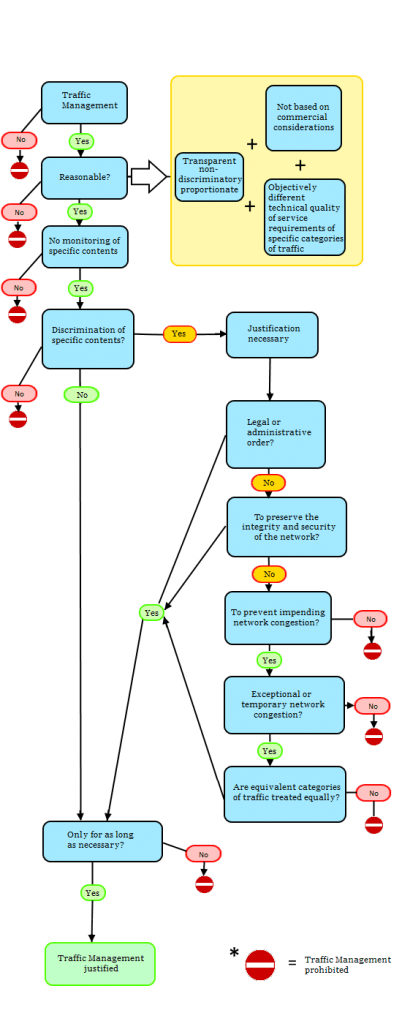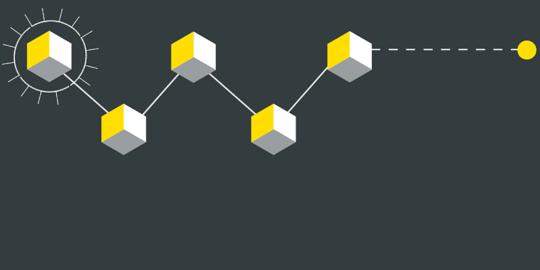When the TSM Regulation with new binding rules for Net Neutrality was adopted, many activists claimed that the new rules were more an “abolition” of net neutrality but an introduction. Why did they make this statement?
Because the Regulation also provides for situations in which access providers can derogate from the general net neutrality obligation.
This is part two of a series of three articles on Net Neutrality. In part 1, I have explained the basics of Net Neutrality and the applicability of the new Net Neutrality rules. In this part 2, I will explain under which conditions internet access providers can derogate from the rule of Net Neutrality. In the final part 3, I explain how the Regulation will be enforced and what is going to happen next.
This namely applies in two cases: In para. 3 subpara. 2 for traffic management and in para. 5 for “special services”.
Admissibility of traffic management
The traffic management regulations are contained in Art. 3 para. 3 subpara.s 2 and 3:
“The first subpara. shall not prevent providers of internet access services from implementing reasonable traffic management measures. In order to be deemed to be reasonable, such measures shall be transparent, non-discriminatory and proportionate, and shall not be based on commercial considerations but on objectively different technical quality of service requirements of specific categories of traffic. Such measures shall not monitor the specific content and shall not be maintained for longer than necessary.
Providers of internet access services shall not engage in traffic management measures going beyond those set out in the second subparagraph, and in particular shall not block, slow down, alter, restrict, interfere with, degrade or discriminate between specific content, applications or services, or specific categories thereof, except as necessary, and only for as long as necessary, in order to:
(a) comply with Union legislative acts, or national legislation that complies with Union law, to which the provider of internet access services is subject, or with measures that comply with Union law giving effect to such Union legislative acts or national legislation, including with orders by courts or public authorities vested with relevant powers; L 310/8 Official Journal of the European Union 26.11.2015 EN
(b) preserve the integrity and security of the network, of services provided via that network, and of the terminal equipment of end-users;
(c) prevent impending network congestion and mitigate the effects of exceptional or temporary network congestion, provided that equivalent categories of traffic are treated equally.”
In summary, this part of the provision states that despite their net neutrality obligation, internet access providers can continue traffic management in their networks. But this exception has counter-exceptions. The following flowchart shows the complexity of the interlocking rules:
Traffic management was already customary before the Regulation, especially to prevent network congestion in peak times, but also to prevent IT security threats (e.g. DDoS- attacks). Even now traffic management is not prohibited. But the Regulation limits the opportunities of the service suppliers, in order to ensure that unjustified discrimination of content is not disguised as “traffic management”.
The prohibition of traffic management based on “commercial considerations” will probably particularly relevant, because ultimately, every access provider is commercially motivated. It will also be difficult to math certain actions of an internet access provider to a particular motivation. Why exactly does a traffic management scheme distribute traffic in a specific way? Usually, technical decisions in this area have multiple causes, and all of them are in way connected to “commercial considerations”. In this respect, it will be an interesting to follow how the national regulatory authorities handle the matter.
Another issue is the limitation of traffic management to a period “only as long as necessary”, and the to justify traffic management only in situations of network congestion that are “exceptional”. The Regulation does define these terms. This will be done later, by the regulatory bodies and eventually it is most likely to involve the courts.
Admissibility of special services
The most hotly debated part of the new Regulation during the law-making process is the set of rules now contained in Art. 3 para. 5 of the Regulation. This para. contains the admission for special services.
The regulation reads as follows:
“(5) Providers of electronic communications to the public, including providers of internet access services, and providers of content, applications and services shall be free to offer services other than internet access services which are optimised for specific content, applications or services, or a combination thereof, where the optimisation is necessary in order to meet requirements of the content, applications or services for a specific level of quality.
Providers of electronic communications to the public, including providers of internet access services, may offer or facilitate such services only if the network capacity is sufficient to provide them in addition to any internet access services provided. Such services shall not be usable or offered as a replacement for internet access services, and shall not be to the detriment of the availability or general quality of internet access services for end-users.”
What is this paragraph about? It is about the “special services”, which are defined as “other services”, therefore not as part of the internet access service. In this matter, the regulation avoids the term “special services”, but uses an abstract definition: The exception applies to “services other than internet access services which are optimised for specific content, applications or services, or a combination thereof”.
At first glance, this definition is hard to interpret. Taking a closer look, the concept of optimisation (“optimised for specific content, applications or services “) is the key part of the definition. This term can be seen as the opposite part of net neutrality: The part of an internet access providers offering which is not optimised for a specific purpose, has to comply with the net neutrality rules. The other part is “optimised and falls (if the conditions of paragraph 5 are met) under the exception clause for special services.
It is noteworthy that Art. 3 para. 5 has a wider scope as the rest of the net neutrality rules in the TSM Regulation. This part of the regulation addresses three types of providers. Besides “internet access providers”, it addresses content providers and also all other “providers of electronic communications to the public”. This term is legally defined in Art. 2 of the Regulation; it is significantly broader than the term “internet access provider”. According to Art. 2 of the Regulation, a “provider of electronic communications to the public” is an undertaking” providing public communications networks or publicly available electronic communications services”.
The fact that the Regulation explicitly authorises content providers and electronic communications providers to offer special services is remarkable. Because a prohibition to offer these services does not exist (at least not in EU law).
Restricted admissibility of special services
The new Regulation limits the right of internet access providers to provide such special services. Access providers may deviate from the basic principle of net neutrality, if three criteria are met:
- The network capacity must be sufficient to provide special services “in addition to any internet access service provided”.
- The special services shall not be usable or offered as a replacement for internet access
- The offering of special services shall not be “to the detriment of the availability or general quality of internet access services”.
All of these three counter-exceptions use very imprecise wording. When is the network capacity “sufficient”? What is a “replacement” for internet access services? And when do end-users or internet access services suffer a “detriment” especially to the “general quality”? The legal meaning of these provisions is totally unclear – their actual meaning will follow from decisions yet to be made.
This is the end of part 2. In part 3, I explain how the Regulation will be enforced and what is going to happen next. For the basics, read The new Net Neutrality Regulation – part 1.





